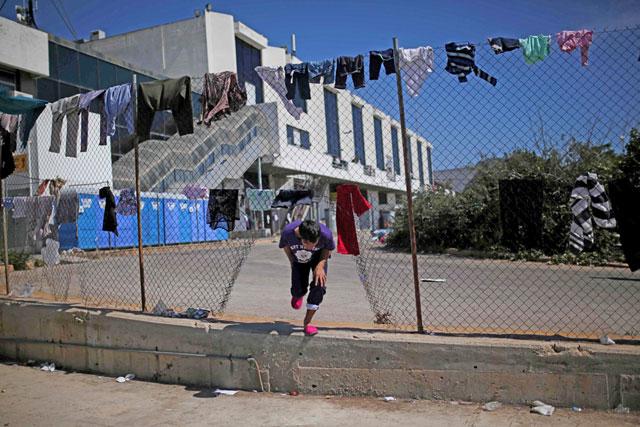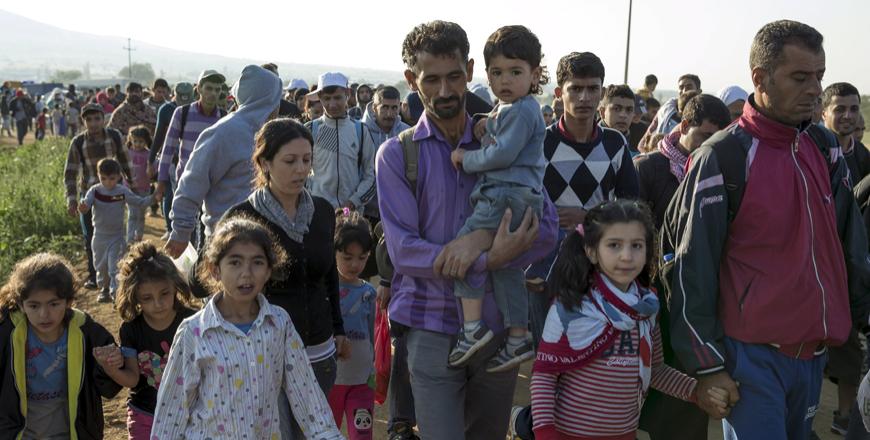You are here
Doors slamming shut in Hungary for asylum seekers
By AFP - Aug 31,2020 - Last updated at Aug 31,2020

This file photo taken on September 4, 2015 shows a migrant girl holding a poster of German Chancellor Angela Merkel as migrants walk in Budapest downtown after leaving the transit zone of the main train station, intending to walk to the Austrian border (AFP photo)
VAMOSSZABADI, Hungary — "It's difficult in a new way for us. There is hardly anyone left to talk to," Karzan Mohamed Sharif Amin, an Iraqi Kurd, told AFP at a government-run shelter in western Hungary.
A father of four, the 37-year-old is one of a handful of asylum seekers still inside Hungary as its doors in effect slam shut for people fleeing war and persecution.
New rules in place since June say asylum seekers must first submit a so-called "declaration of intent" at one of the country's embassies abroad, rather than on arrival at the border as before.
From 2017, asylum seekers were automatically parked in controversial frontier "transit zone" camps while their applications were processed.
But in May the EU's top court ruled that this amounted to unlawful detention.
Prime Minister Viktor Orban's hardline anti-immigration government then shut the two camps and moved the almost 300 people there to open facilities away from the border.
'Inefficient' system
Stuck at the Tompa transit zone for almost two years, Amin and his family were moved to the Vamosszabadi centre near the Slovakian border, from where he says most asylum-seekers have since quietly left for western Europe.
But he himself is hopeful of still having his case accepted — having first applied in September 2018.
Though human rights groups welcomed the closing of the transit camps, the continuing long legal process endured by Amin is typical of the "inefficient" system, said Timea Kovacs, a lawyer with the Hungarian Helsinki Committee (HHC).
"Cases go slowly for no reason, while kids miss out on school, and adults on integration," she told AFP.
Amin, unable to work while waiting for a judgement on his application, says he just wants his children — the youngest of whom was born at Tompa — to go to school and "be happy".
If he had stayed in Iraq, he feared they would have ended up either in the military or the Kurdistan Workers' Party.
"But after we entered Tompa we had more problems and pains than in Iraq," he said. "I could not understand why my children must grow up in prison in Hungary."
The heavily guarded camps were built alongside the fortified border fence that Orban erected in 2015.
Asylum-seekers were housed in metal shipping containers, with a turnstile allowing entry to the camp from the Serbian side.
In dozens of cases brought to the European Court of Human Rights by the HHC, rejected applicants were also denied food.
Budapest maintained that asylum-seekers could return to Serbia at any time, but the Court of Justice of the European Union in its May ruling said exiting that way would violate Serbian law, in practice trapping inmates in a legal no man's land.
'Border defence tougher'
Orban blasted the CJEU ruling as an effort to force Budapest to let in migrants.
"We responded to the attack in Brussels by making border defence even tougher," he said.
Now the Hungarian asylum authority has two months to assess applicants' "declarations of intent" to seek protection lodged at embassies in neighbouring countries.
"That's where they'll have to wait," said Orban.
If approved, a month of automatic detention in Hungary follows.
"Until the end of July, seven persons submitted letters of intent," in Serbian capital Belgrade, the Hungarian foreign ministry told AFP.
Entry to the transit zones had already been suspended indefinitely in March as European countries shut their borders over new coronavirus fears.
According to the UN's refugee agency, it is now impossible for any asylum seeker who approaches Hungary to enter the country legally and seek protection.
This constitutes a "breach of EU and international refugee law", said its Hungarian spokesman Erno Simon.
"The government has practically got rid of all the asylum seekers," Simon told AFP.
At the same time, according to Hungarian police data on "illegal migration" in 2020, around 20,000 people without documents were apprehended within Hungary or on trying to enter the country by August — despite a three-month lull caused by the virus-related border closures.
Those held have either been "escorted" back across the border fence into Serbia, blocked from entry, or held in custody, according to police.
Data from the UN refugee agency in Belgrade showed that in July alone, 804 people were pushed back from Hungary.
Back in Vamosszabadi, less than 15 of the asylum-seekers moved there in May remain, according to Amin.
He plans to stay in Hungary if he receives refugee status when his case is finally, he hopes, concluded next month.
"It's an EU country after all, isn't it," he said.
Related Articles
BUDAPEST — A Syrian migrant drowned in the Tisza river last week as he was trying to cross from Serbia to Hungary, police said on Monday, an
HORGOS, Serbia — Exhausted but hopeful, hundreds of migrants defy summer heat in a makeshift camp on the Serbia-Hungary border, d
ROSZKE, Hungary — A surge in migrants, many of them refugees from Syria, hit Hungary's southern border on Tuesday, passing through gaps in a



















